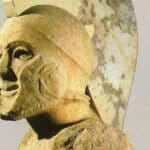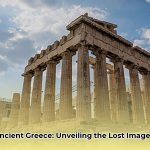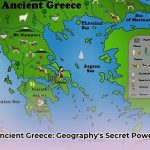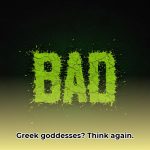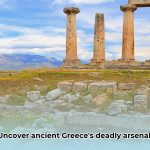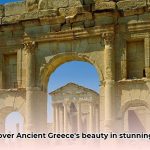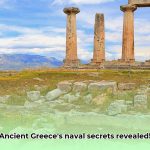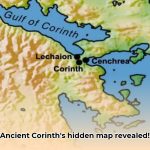Ever wondered about those striking symbols gracing everything from high-fashion runways to blockbuster movies, hinting at a connection to ancient Greece? These aren’t mere aesthetic embellishments; they’re potent visual emblems that resonated deeply with the ancient Greeks. Consider them as more than just ancient versions of emojis. Instead of conveying fleeting emotions, they encapsulate entire narratives about deities, legendary heroes, and profound existential mysteries. This article serves as your definitive guide to interpreting these age-old markings. We will delve into their origins, decipher their significance within their original context, and trace how their meanings have morphed over time. From the awe-inspiring thunderbolt wielded by Zeus to the spine-chilling visage of Medusa, this exploration reveals the captivating stories woven into each symbol and illuminates their continuing influence on our contemporary world. For more examples of ancient Greek jewelry, see these examples.
Ancient Greece Symbols: A Journey Through Time
Envision ancient Greece: a realm brimming with valorous heroes, omnipotent gods, and stirring sagas—a civilization that bequeathed to posterity a wealth of heritage, a keystone of which consists of its intricate system of symbols. Far surpassing mere ornamentation, these symbols functioned as robust visual conduits for communicating multifaceted concepts, embedded beliefs, and societal norms. Embark with us as we decipher these compelling icons, uncovering their enduring significance across millennia. What accounts for the unwavering allure of these symbols, even after the passage of epochs?
Gods, Goddesses, and Their Symbolic Representations: Divine Iconography
Picture ancient Greece: a society where divine beings were perceived as tangibly as the sun’s radiance. Their very presence permeated quotidian existence, and symbols functioned as a visual vernacular, forging connections between mortals and the divine realm. Consider Zeus, the supreme ruler of the gods. His emblem, the thunderbolt, transcended its role as a mere weapon. It stood as a vivid portrayal of his unbridled might, his indisputable sovereignty, and his capacity to unleash devastating tempests. Artisans portrayed the thunderbolt across a spectrum of forms. At times rendered as a stark, angular zigzag; at others, as a dramatically spiraling cascade of luminosity. Every interpretation delicately conveyed the manifold aspects of his formidable power.
Then there’s Athena, revered as the goddess of sagacity and strategic warfare. Her iconic symbol, the owl—an animal celebrated for its acute perception and silent flight—personified intelligence, strategic acumen, and protective guardianship. This emblem adorned coinage, pottery, and sculptural works, serving as a subtle yet persistent reminder of Athena’s watchful presence. Similarly, Poseidon, the imperious god of the seas, brandished a trident—a three-pronged spear—that symbolized his dominion over oceanic expanses and his tempestuous temperament. These symbolic selections were far from arbitrary. Every emblem meticulously mirrored the distinct persona and realm of the divinities they represented.
However, the symbolic idiom extended far beyond the principal divinities. Lesser-known gods and goddesses also possessed their unique emblems, thereby enriching the diverse tapestry of ancient Greek religious expression. The study of these more obscure symbols offers invaluable insights into the breadth and depth of ancient Greek religious convictions and customs. Ongoing scholarly investigations continue to disclose novel interpretations and significations associated with these lesser-known emblems, thereby augmenting our comprehension of ancient Greek religious practices.
Power, Authority, and the Symbols That Defined Them: Royal Symbols
Ancient Greek society encompassed more than its pantheon of gods. It featured a complex social stratification mirrored in its diverse array of symbols. The laurel wreath, for example, was more than a mere decorative circlet. It ascended to prominence as a potent signifier of victory and notable accomplishments. Initially adorning the brow of Olympic victors, it progressively evolved to embody universal triumph and esteemed honor, ultimately gracing the heads of emperors and distinguished heroes. The evergreen essence of laurel represented enduring glory.
The scepter, a majestic staff frequently capped with an eagle or another symbolic totemic figure, served as another paramount symbol. It embodied royal sovereignty, legitimacy, and, within certain explications, a celestial bridge uniting the ruler with the divine. To grasp a scepter transcended a mere ceremonial gesture. It served as a compelling visual affirmation of power, a definitive declaration of the ruler’s inalienable right to govern. These symbols were not mere decorative enhancements. They were inextricably interwoven into the social fabric, fortifying the prevailing power structures and preserving social order.
Life, Death, and the Eternal Cycle: Ancient Greek Perspectives: Cyclical Symbols
The ancient Greeks possessed an acute perception of life’s cyclical rhythms and the inevitability of mortality. This Weltanschauung finds poignant expression across many of their symbols. The Ouroboros, a serpent consuming its own tail, exemplifies this cyclical concept with striking clarity. This symbol stands for the perpetual cadence of creation and destruction, of genesis and resurrection, mirroring the ceaseless regeneration evident in nature. It proposes an unceasing cycle, a timeless loop of existence.
In stark contrast to the Ouroboros, the cornucopia—a horn lavishly overflowing with fruits, blossoms, and grains—embodies abundance, prosperity, and fertility. This emblem conjures images of fertile landscapes, copious harvests, and the munificent blessings bestowed by nature. These sharply contrasting emblems—the Ouroboros and the cornucopia—mirror the vicissitudes and benedictions inherent in life as perceived by the Greeks. They underscore both the repetitive patterns discernible in the natural realm and humankind’s dependence for sustenance and prosperity.
The Labrys: A Symbol Shrouded in Mystery: Double-Headed Axe
The labrys, the distinctive double-headed axe, emerges as one of the more cryptic symbols from ancient Greece. Its origins, shrouded in a degree of ambiguity, have spawned a diverse array of interpretations. Some scholars connect it to Minoan culture and its veneration of potent female deities, suggesting the labrys signifies feminine potency and possibly duality. Others associate it with the Amazons, the storied sisterhood of warrior women, thereby endowing it with connotations of strength and fierce independence. Intriguingly, the labrys has undergone a remarkable resurgence in modern times, finding resonance with the LGBTQ+ community, underscoring the propensities of symbols to adopt altogether novel meanings across disparate cultures and epochs.
The Gorgon’s Head: From Protective Amulet to Fashion Icon: Medusa’s Imagery
The formidable visage of the Gorgon’s head initially functioned as a potent apotropaic instrument—an emblematic device intended to deflect malevolence. Its piercing gaze was thought to furnish protection against harm, functioning as a forceful safeguard against insidious forces. Nevertheless, its arresting imagery has transcended its ancient provenance, permeating into contemporary fashion, most notably through its pervasive deployment by the Versace brand. This metamorphosis—from an ancient protective amulet to a motif gracing high fashion—testifies to the abiding puissance of ancient Greek iconography and the inherently fluid character of symbolic explication. It exemplifies the capacity of symbols to conserve fragments of their initial significance while concurrently embracing supplementary strata of meaning within novel cultural contexts.
Decoding the Ancient Greek Symbolic Language: A Continuous Quest
To fully decipher ancient Greek symbols surpasses the rudimentary act of image identification. It entails an exhaustive immersion into their historical, cultural, and religious milieu. Meanings were never uniformly consistent; interpretations exhibited considerable variability contingent upon temporal and spatial contexts. Numerous scholars posit that the meanings ascribed to these symbols were initially more localized in scope, gradually evolving and undergoing transformations as they diffused across disparate regions. Future scholarly inquiry remains indispensable for exploring the plethora of regional interpretations and elucidating their collective contribution to the holistic evolution of symbolic significance.
The enduring puissance of ancient Greek symbols resides in their capacity to resonate across millennia. They provide a portal through which to apprehend the ethos and lives of the ancient Greeks, unveiling their cherished values, embedded beliefs, and intricate social frameworks. These symbols furnish an inexhaustible reservoir of insight for historians, archaeologists, and fervent enthusiasts of culture. Furthermore, they speak to an ageless predilection within humanity for comprehending the deeper significance embedded within visual imagery, serving as a perpetual reminder of the fluid and perpetually evolving сущность of symbolism.
How to Interpret the Symbolism of Ancient Greek Labrys Across Different Time Periods
Key Takeaways:
- The labrys, a distinct double-headed axe, bore multifaceted symbolic significances throughout differing epochs.
- Its Minoan roots suggest associations with feminine potency and veneration of a Mother Goddess.
- Later interpretations connected the labrys to disparate deities and mythological personae, each imparting unique symbolic value.
The Minoan Enigma: Early Interpretations of the Labrys: Decoding the Axe
The labrys is not simply an artifact of antiquity; it emerges as a compelling symbol deeply enmeshed with myriad layers of profound meaning. Its trajectory through time commences on Minoan Crete, a Bronze Age civilization renowned for its dynamic culture and intricate artistic creations. There, the labrys occupied a prominent place, recurrently depicted in frescoes, pottery, and architectural embellishments of palaces. What implications can be deduced from this pervasive presence? Did it function strictly as a religious artifact, or did it fulfill further practical objectives, potentially melding religious significance with ceremonial application? This inquiry underscores the pivotal importance of understanding how to interpret the symbolism of ancient greek labrys across different time periods. Innumerable scholars assert that the labrys linked indissolubly with a revered Minoan Mother Goddess, symbolizing her dominion over fertility and generative forces. However, alternative explication persists, accentuating the intrinsic challenge of deciphering ancient symbolism.
Beyond Crete: Expanding Interpretations: Cultural Diffusion
Subsequent to the waning influence of Minoan civilization, the labrys persisted in diverse contexts. Its acceptance and adaptation by disparate cultures each imbued it with unique connotations. Did these subsequent alterations dilute the initial Minoan intent, or did they authenticate the labrys’ adaptability as a robustly resonant visual motif? We observe its presence in Mycenaean Greece, frequently associated with warrior-kings and potentially linked to the cult of Zeus. The dual blades of the labrys, some posit, may embody the intrinsically dualistic nature of existence, encapsulating both life and death, or potentially mirroring male and female energies. Thus, how to interpret the symbolism of ancient greek labrys across different time periods hinges on an exhaustive comprehension of its discrete cultural and historical contexts.
The Labrys in Modern Times: A Symbol Reforged: LGBTQ+ Symbolism
The labrys’ odyssey transcends the boundaries of antiquity. In contemporary times, it has undergone a remarkable resurgence, particularly within feminist and LGBTQ+ movements. Why has this age-old symbol experienced renewed relevance in the twenty-first century? Its association with feminine potency in Minoan society has resonated powerfully, transforming it into a potent symbol of resilience and self-determination for many. The double-headed axe embodies a strength that transcends conventional gender mores, and, for a segment of advocates, its connections with the mythical Amazons augment its emblematic resonance.
Navigating the Complexities: A Methodology for Interpretation
To accomplish a substantiated interpretation of the labrys mandates a nuanced methodology that recognizes its historical trajectory and the multiplicity of symbolic interpretations ascribed to it. This methodological approach necessitates:
- Contextual Analysis: A thorough assessment of the particular cultural and temporal milieu in which the labrys appears.
- Visual Examination: A meticulous scrutiny of the artistic representation of the labrys, encompassing its stylistic characteristics, contextual embedding within the artwork, and any accompanying symbols.
- Comparative Study: A deliberate juxtaposition of different representations of the labrys across disparate cultures and epochs, thereby elucidating convergences and divergences in interpretation.
- Historical Research: The solicitation of evidentiary substantiation from historical texts and archaeological findings directly pertaining to the labrys.
- Critical Engagement: The acknowledgement of divergent interpretations while conscientiously eschewing the imposition of contemporary biases onto age-old symbols, thereby upholding a judicious and respectful exegesis.
By assiduously adhering to these methodological steps, we can unlock the multifaceted strata of meaning ensconced within this compelling symbol, thereby appreciating its rich history and its complex trajectory throughout the annals of civilization.
https://studyofsymbols.com/labrys-history-meaning-of-symbols-2/
Ancient Greek Symbols in Modern Branding and Design Applications
Key Takeaways:
- Ancient Greek symbols resonate deeply with audiences, furnishing brands with a robustly compelling nexus to consumers steeped in historical significance.
- A successful application necessitates a meticulous deliberation of the symbol’s pristine connotation and its susceptibility to potential misinterpretation.
- Contemporary explications must guard against cultural insensitivity and counteract the perpetuation of detrimental stereotypes.
Decoding the Myths: Symbolism and Meaning: Branding with Classics
Let us delve into the expansive domain of Ancient Greek Symbols in Modern Branding and Design Applications. Consider the pantheon of iconic brands that artfully embed ancient Greek imagery either subtly or overtly. Its ubiquity underscores its efficacy as a strategic tool. But what factors underlie its appeal? These symbols, far exceeding mere aesthetic ornamentation, carry centuries of accumulated significance, embodying fundamental concepts such as puissance, transcendent beauty, and the vicissitudes of mortality.
Categorizing the Classics: Themes and Associations: Ancient Greek Symbolism
We can systematically categorize these potent symbols according to their thematic underpinnings. Symbols indicative of divinity, such as Zeus’ emblematic thunderbolt, convey strength and unwavering authority. Consider how a brand might harness this imagery to evoke notions of leadership and dominion. Conversely, symbols traditionally associated with the underworld, specifically Cerberus, the formidable three-headed canine guardian, could impart an aura of enigmatic allure or exclusive distinction. It is truly remarkable how a single visual emblem possesses the intrinsic ability to convey a surfeit of nuanced connotations. Similarly, symbols depicting life’s labyrinthine trajectory, exemplified by the archetype of the labyrinth, insinuate complexity and the arduous path toward enlightenment. This offers an expansive tableau of prospects for forward-thinking brands seeking to propagate comparable narratives.
The Medusa’s Gaze: Evolving Interpretations: Versace
Consider Medusa, the petrifying Gorgon whose gaze held the power to transmute mortals into inanimate stone. Within the contextual framework of ancient myths, Medusa epitomized stark terror and insurmountable peril. Conversely, in a daring appropriation, Versace emphatically deploys her head as its emblematic brand symbol. This radical inversion of semiotic intent underscores the fluid, malleable сущность of symbolism and the transformative potential of reinterpretation. The linchpin to responsibly harnessing these symbols lies in vigilantly monitoring this continual evolution and ensuring that their contemporary applications scrupulously respect their originating source material.
Navigating the Modern Landscape: Responsible Application: Symbol Usage
The judicious utilization of Ancient Greek Symbols in Modern Branding and Design Applications presents itself as a potent strategic gambit. However, it imposes a concomitant imperative to proceed with measured circumspection. Erroneous interpretations portend far-reaching ramifications. A subset of symbols harbor deeply entrenched cultural meanings, and their inadvertent misconstrual or insensitive appropriation could ignite widespread dissension. To mitigate the deleterious potentials inherent in such undertakings, it becomes incumbent upon modern entities to diligently undertake exhaustive research and solicit counsel from cultural experts.
Modern Applications: Successes and Challenges
Numerous brands adeptly harness the evocative power of ancient Greek symbols. Nike’s deployment of the winged figure of victory finds intrinsic linkage to the realms of athletic proficiency and triumphant achievement. Conversely, alternative brand endeavors frequently culminate in relative inefficacy. A superficial or imprudent application risks trivializing the opulent historical contexts that these symbols seek to represent. It is paramount to contemplate the prospective repercussions on consumer perception. Do brands aspire to engender inspiration or inadvertently foster alienation?
| Symbol Category | Example Symbol | Potential Brand Application | Potential Pitfalls |
|---|---|---|---|
| Divinity | Zeus’ Thunderbolt | Strength, Power, Authority | Misrepresentation of the inherent character of gods |
| Underworld | Cerberus | Mystery, Exclusivity, Transformation | Evoking negative connotations unintentionally |
| Life Cycle/Journey | Labyrinth | Complexity, Discovery, Transformation | Oversimplifying the rich context of a symbol |
| Victory/Achievement | Nike’s Winged Victory | Athletic Achievement, Triumph, Success | Overshadowing the original message of the brand |
| Feminine Power/Strength | Athena | Wisdom, Strategic thinking, Strength | Reinforcing stereotypes |
Exploring the Evolution of Ancient Greek Symbol Interpretations Across Cultures
Key Takeaways:
- Ancient Greek symbols, far exceeding mere aesthetic configurations, functioned as vehicles for conveying intrinsically complex ideas and beliefs.
- The meanings ascribed to these symbols underwent a process of transfiguration across diverse temporal and cultural contexts, albeit with the retention of core conceptual elements.
- Comprehensive comprehension of these symbols necessitates scrupulous examination of their contextual embedding.
Symbols of Divinity: Power and Piety: The Gods’ Presence
Envision yourself standing in reverent veneration before a towering effigy of Zeus, his formidable thunderbolt brandished aloft. That singular symbol—the thunderbolt—instantaneously transmits a powerful message of divine puissance and incontestable authority. Similarly, contemplate the olive branch, a ubiquitous symbol representative of peace, frequently associated with Athena, the sagacious goddess of wisdom. Such symbols, imbued with profound connotative weight, instantaneously evoked the compelling presence and unassailable power of the gods within the daily life of ancient Greece. Their meanings, however, were far from static. The same symbols could elicit disparate interpretations across disparate city-states or even within divergent artistic iterations. The serpent, commonly associated with Asclepius as a signifier of healing, could also connote deceit or imminent peril, as exemplified by its association with the serpentine adornments of Medusa. This nuanced dichotomy underscores the fundamental importance of Exploring the Evolution of Ancient Greek Symbol Interpretations Across Cultures.
Symbols of Power and Governance: Ruling Symbols
The laurel wreath, universally recognized as an emblem of victory, serves as a quintessentially representative archetype. Visualize its presence adorning the craniums of triumphant athletes or distinguished military commanders. Its significance transcended the prosaic demarcation of sheer triumph, extending to the symbolic articulation of societal recognition and the venerated ideals of honor and exceptional achievement. Conversely, a comprehensive exploration of its utilization across diverse temporal periods reveals nuanced shifts in its specific applications and overarching meaning. Given the limited capacity for widespread dissemination of information inherent in the absence of social media, how did the multifaceted signification of the Laurel Wreath gain traction?
Life Cycles and Mortality: Symbols of Change: Mortality and Symbols
What of the labyrinth? While intrinsically associated with the mythical Minotaur, its intricately winding paths also constitute a potent metaphor for the inherent complexities of life’s arduous voyage and the inevitable tribulations that one confronts en route. This interpretative angle accentuates the abiding salience of ancient symbols across manifold cultural contexts. The intrinsic association of these symbols with the ubiquitous phenomenon of mortality exerted a palpable influence on their utilization. Ponder, for instance, the Gorgoneion—the severed head of Medusa—frequently deployed as a protective apotropaic device. Its menacing visage served as a formidable ward against latent malevolence.
The Labrys: A Case Study in Debate: Examining an Axe
The double-headed axe, commonly identified as the Labrys, presents itself as a compelling case study in interpretive ambiguity. While its precise origins remain subject to scholarly debate, the Labrys maintains enduring linkage to an assortment of female deities. As such, the Labrys has undergone diverse interpretations across various cultural periods and geographical regions, diverging from its symbolic representation of feminine power to its utilization as a sacred implement. A comprehensive comprehension of this inter-cultural variance elucidates the inherent challenges intrinsic to Exploring the Evolution of Ancient Greek Symbol Interpretations Across Cultures.
Modern Appropriations: Enduring Relevance: Greek Symbols
Even within our contemporary epoch, the indelible imprint of ancient Greek symbols continues to permeate myriad facets of modern culture. The haunting gaze of the Gorgon’s head, for example, manifests conspicuously within Versace’s brand iconography. It represents an irrefutable testament to the enduring allure, aesthetic dynamism, and deeply embedded cultural significance of ancient Greek symbols. As this trend persists, it becomes incumbent upon us to vigilantly assess the appropriation of such symbols within contemporary contexts with an unwavering commitment to cross-cultural sensitivity.
A Continuous Journey of Discovery
The intellectual expedition of Exploring the Evolution of Ancient Greek Symbol Interpretations Across Cultures constitutes an ongoing process, ever-unfolding with new discoveries. By meticulously considering historical contexts, stylistic artistic characteristics, and culturally sensitive appropriations, we cultivate an enriched understanding of these captivating symbols. Their multifaceted interpretations serve as a potent reminder of the remarkable capacity of symbolism to encapsulate the myriad complexities of human cultures and ideas.
- Ancient Greece Aristocracy: Rise and Fall of Power - August 9, 2025
- Rediscover the Bad Girls of Ancient Greece: A Feminist Retelling - August 9, 2025
- Discover Ancient Greece Weapons: A Comprehensive Guide to Military Technology - August 8, 2025


